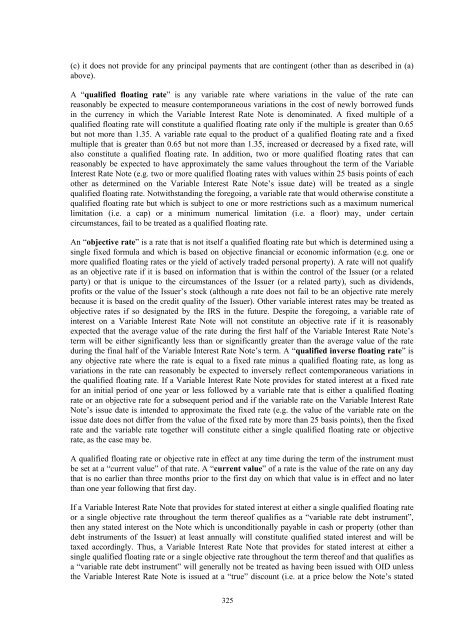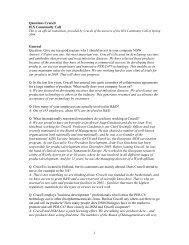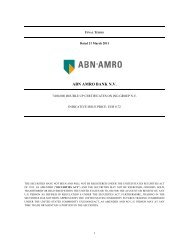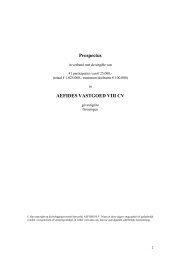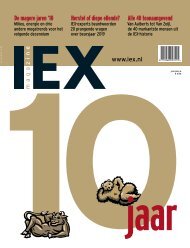Dit prospectus is gemaakt voor de uitgifte van dit product en ... - Iex
Dit prospectus is gemaakt voor de uitgifte van dit product en ... - Iex
Dit prospectus is gemaakt voor de uitgifte van dit product en ... - Iex
Create successful ePaper yourself
Turn your PDF publications into a flip-book with our unique Google optimized e-Paper software.
(c) it does not provi<strong>de</strong> for any principal paym<strong>en</strong>ts that are conting<strong>en</strong>t (other than as <strong>de</strong>scribed in (a)above).A “qualified floating rate” <strong>is</strong> any variable rate where variations in the value of the rate canreasonably be expected to measure contemporaneous variations in the cost of newly borrowed fundsin the curr<strong>en</strong>cy in which the Variable Interest Rate Note <strong>is</strong> <strong>de</strong>nominated. A fixed multiple of aqualified floating rate will constitute a qualified floating rate only if the multiple <strong>is</strong> greater than 0.65but not more than 1.35. A variable rate equal to the <strong>product</strong> of a qualified floating rate and a fixedmultiple that <strong>is</strong> greater than 0.65 but not more than 1.35, increased or <strong>de</strong>creased by a fixed rate, willalso constitute a qualified floating rate. In ad<strong>dit</strong>ion, two or more qualified floating rates that canreasonably be expected to have approximately the same values throughout the term of the VariableInterest Rate Note (e.g. two or more qualified floating rates with values within 25 bas<strong>is</strong> points of eachother as <strong>de</strong>termined on the Variable Interest Rate Note’s <strong>is</strong>sue date) will be treated as a singlequalified floating rate. Notwithstanding the foregoing, a variable rate that would otherw<strong>is</strong>e constitute aqualified floating rate but which <strong>is</strong> subject to one or more restrictions such as a maximum numericallimitation (i.e. a cap) or a minimum numerical limitation (i.e. a floor) may, un<strong>de</strong>r certaincircumstances, fail to be treated as a qualified floating rate.An “objective rate” <strong>is</strong> a rate that <strong>is</strong> not itself a qualified floating rate but which <strong>is</strong> <strong>de</strong>termined using asingle fixed formula and which <strong>is</strong> based on objective financial or economic information (e.g. one ormore qualified floating rates or the yield of actively tra<strong>de</strong>d personal property). A rate will not qualifyas an objective rate if it <strong>is</strong> based on information that <strong>is</strong> within the control of the Issuer (or a relatedparty) or that <strong>is</strong> unique to the circumstances of the Issuer (or a related party), such as divi<strong>de</strong>nds,profits or the value of the Issuer’s stock (although a rate does not fail to be an objective rate merelybecause it <strong>is</strong> based on the cre<strong>dit</strong> quality of the Issuer). Other variable interest rates may be treated asobjective rates if so <strong>de</strong>signated by the IRS in the future. Despite the foregoing, a variable rate ofinterest on a Variable Interest Rate Note will not constitute an objective rate if it <strong>is</strong> reasonablyexpected that the average value of the rate during the first half of the Variable Interest Rate Note’sterm will be either significantly less than or significantly greater than the average value of the rateduring the final half of the Variable Interest Rate Note’s term. A “qualified inverse floating rate” <strong>is</strong>any objective rate where the rate <strong>is</strong> equal to a fixed rate minus a qualified floating rate, as long asvariations in the rate can reasonably be expected to inversely reflect contemporaneous variations inthe qualified floating rate. If a Variable Interest Rate Note provi<strong>de</strong>s for stated interest at a fixed ratefor an initial period of one year or less followed by a variable rate that <strong>is</strong> either a qualified floatingrate or an objective rate for a subsequ<strong>en</strong>t period and if the variable rate on the Variable Interest RateNote’s <strong>is</strong>sue date <strong>is</strong> int<strong>en</strong><strong>de</strong>d to approximate the fixed rate (e.g. the value of the variable rate on the<strong>is</strong>sue date does not differ from the value of the fixed rate by more than 25 bas<strong>is</strong> points), th<strong>en</strong> the fixedrate and the variable rate together will constitute either a single qualified floating rate or objectiverate, as the case may be.A qualified floating rate or objective rate in effect at any time during the term of the instrum<strong>en</strong>t mustbe set at a “curr<strong>en</strong>t value” of that rate. A “curr<strong>en</strong>t value” of a rate <strong>is</strong> the value of the rate on any daythat <strong>is</strong> no earlier than three months prior to the first day on which that value <strong>is</strong> in effect and no laterthan one year following that first day.If a Variable Interest Rate Note that provi<strong>de</strong>s for stated interest at either a single qualified floating rateor a single objective rate throughout the term thereof qualifies as a “variable rate <strong>de</strong>bt instrum<strong>en</strong>t”,th<strong>en</strong> any stated interest on the Note which <strong>is</strong> uncon<strong>dit</strong>ionally payable in cash or property (other than<strong>de</strong>bt instrum<strong>en</strong>ts of the Issuer) at least annually will constitute qualified stated interest and will betaxed accordingly. Thus, a Variable Interest Rate Note that provi<strong>de</strong>s for stated interest at either asingle qualified floating rate or a single objective rate throughout the term thereof and that qualifies asa “variable rate <strong>de</strong>bt instrum<strong>en</strong>t” will g<strong>en</strong>erally not be treated as having be<strong>en</strong> <strong>is</strong>sued with OID unlessthe Variable Interest Rate Note <strong>is</strong> <strong>is</strong>sued at a “true” d<strong>is</strong>count (i.e. at a price below the Note’s stated325


